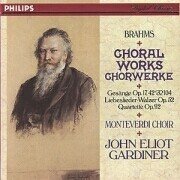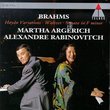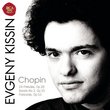| All Artists: Johannes Brahms, John Eliot Gardiner, Monteverdi Choir, Delyth Wynne, Anthony Halstead, Christian Rutherford, Teresa Shaw, John Perry, Philip Salmon Title: Brahms: Choral Works Members Wishing: 0 Total Copies: 1 Label: Philips Release Date: 5/12/1992 Genres: Folk, Pop, Classical Styles: Vocal Pop, Opera & Classical Vocal Number of Discs: 1 SwapaCD Credits: 1 UPC: 028943215220 |
Search - Johannes Brahms, John Eliot Gardiner, Monteverdi Choir :: Brahms: Choral Works
 | Johannes Brahms, John Eliot Gardiner, Monteverdi Choir Brahms: Choral Works Genres: Folk, Pop, Classical
The Monteverdi Choir excels during the a capella selections (Opus 42 and 104) due to their precision tuning and group sensitivity. Brahms's deep, romantic textures and mounds of sound are most vividly experienced when no i... more » ![header=[] body=[This CD is available to be requested as disc only.]](/images/attributes/disc.png?v=909bf926) ![header=[] body=[This CD is available to be requested with the disc and back insert.]](/images/attributes/disc_back.png?v=909bf926) ![header=[] body=[This CD is available to be requested with the disc and front insert.]](/images/attributes/disc_front.png?v=909bf926) ![header=[] body=[This CD is available to be requested with the disc, front and back inserts.]](/images/attributes/disc_front_back.png?v=909bf926) |
Larger Image |
CD Details
Synopsis
Amazon.com
The Monteverdi Choir excels during the a capella selections (Opus 42 and 104) due to their precision tuning and group sensitivity. Brahms's deep, romantic textures and mounds of sound are most vividly experienced when no instruments join in the blend. But in the accompanied pieces (Opus 92, 17, and the Liebeslieder Waltzes, Opus 52), the chorus sounds mechanical, metronomic. The Waltzes are pleasant, but the group can't find a personal identity to enliven the expressiveness of the material; they are simply a poetic mural. Still, this disk, chock full of music, is a lot of worthwhile Brahms for your bucks. --Barbara Eisner Bayer

 Track Listings (34) - Disc #1
Track Listings (34) - Disc #1



